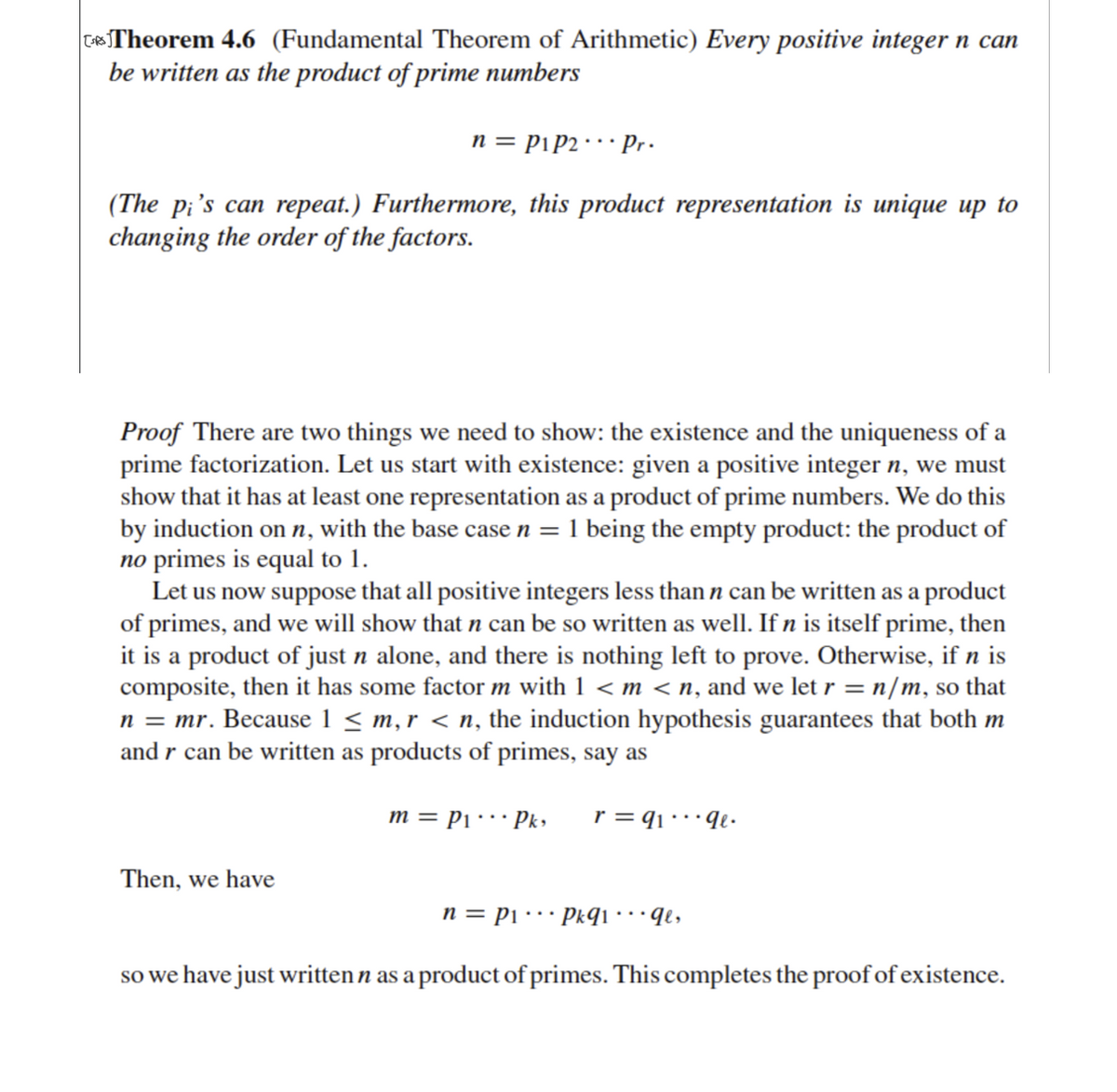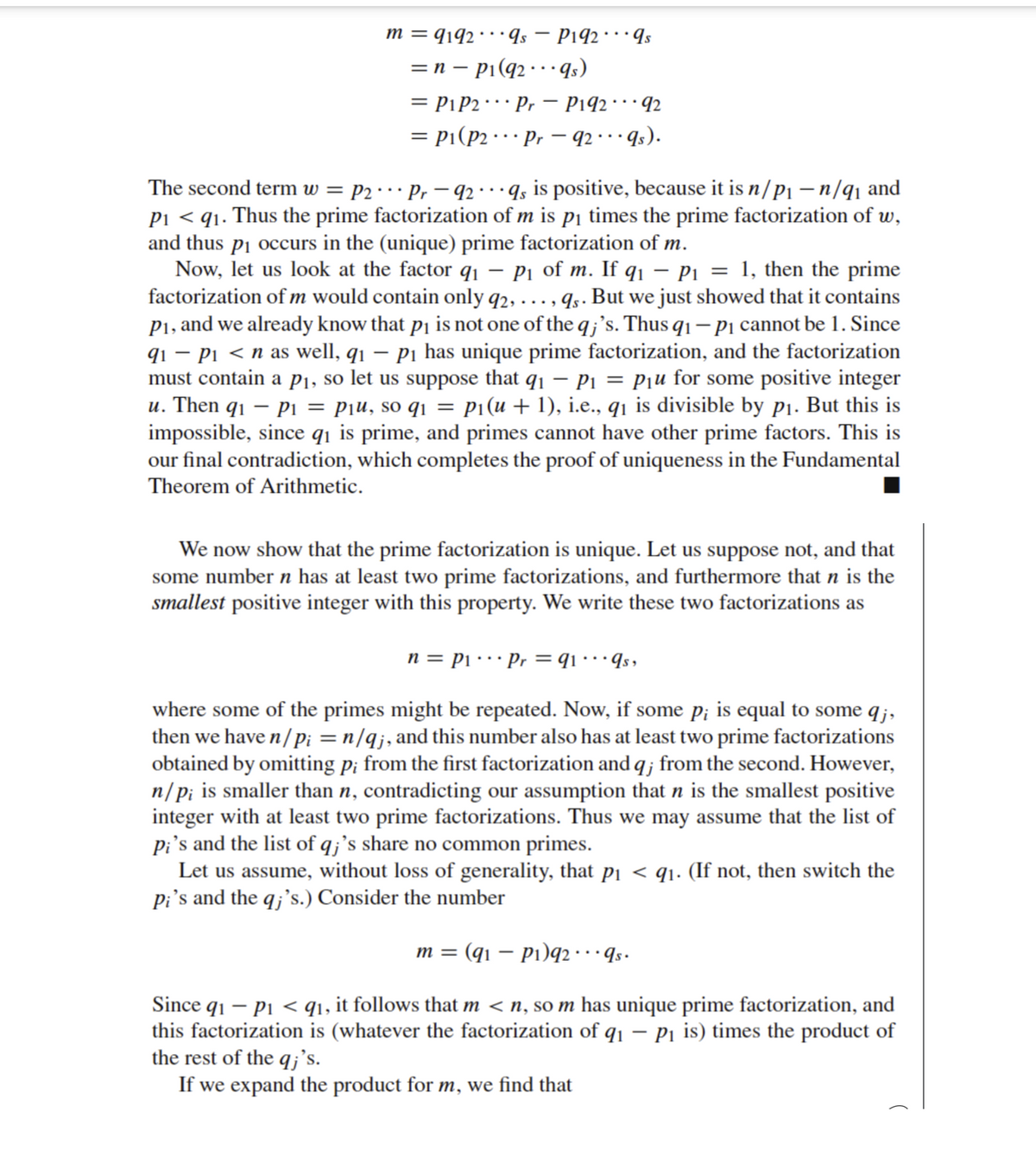Theorem 4.6 (Fundamental Theorem of Arithmetic) Every positive integer n can be written as the product of prime numbers n = P1 P2 Pr. unique up to (The pi's can repeat.) Furthermore, this product representation changing the order of the factors.
Theorem 4.6 (Fundamental Theorem of Arithmetic) Every positive integer n can be written as the product of prime numbers n = P1 P2 Pr. unique up to (The pi's can repeat.) Furthermore, this product representation changing the order of the factors.
Algebra & Trigonometry with Analytic Geometry
13th Edition
ISBN:9781133382119
Author:Swokowski
Publisher:Swokowski
Chapter1: Fundamental Concepts Of Algebra
Section1.2: Exponents And Radicals
Problem 92E
Related questions
Question
100%
it's hard to understand this theory , would you explain in in simple way

Transcribed Image Text:CTheorem 4.6 (Fundamental Theorem of Arithmetic) Every positive integer n can
be written as the product of prime numbers
n = Pip2· · Pr.
(The pi's can repeat.) Furthermore, this product representation is unique up to
changing the order of the factors.
Proof There are two things we need to show: the existence and the uniqueness of a
prime factorization. Let us start with existence: given a positive integer n, we must
show that it has at least one representation as a product of prime numbers. We do this
by induction on n, with the base case n =1 being the empty product: the product of
no primes is equal to 1.
Let us now suppose that all positive integers less than n can be written as a product
of primes, and we will show that n can be so written as well. If n is itself prime, then
it is a product of just n alone, and there is nothing left to prove. Otherwise, if n is
composite, then it has some factor m with 1 < m < n, and we let r = n/m, so that
n = mr. Because 1 < m, r < n, the induction hypothesis guarantees that both m
and r can be written as products of primes, say as
m = P1· Pk»
r = q1· · · qe•
Then, we have
n = Pi ·…· Pkqi• • • ¶e,
so we have just written n as a product of primes. This completes the proof of existence.

Transcribed Image Text:m = 9192 · · · 9s – P192 · · · s
=n – pi(q2 · · · 4s)
= P1P2•·· Pr – P192 ·· · 92
= pi(P2 ·.· Pr – 92 ·· · ¶s).
The second term w = P2 · · · P, – 92 ··· ¶s is positive, because it is n/p1–n/qq and
Pi < q1. Thus the prime factorization of m is på times the prime factorization of w,
and thus pi occurs in the (unique) prime factorization of m.
Now, let us look at the factor q1 – Pı of m. If q1 – Pi = 1, then the prime
factorization of m would contain only q2, ..., qs. But we just showed that it contains
P1, and we already know that p¡ is not one of the q ;'s. Thus q1 – Pj cannot be 1. Since
q1 – Pi <n as well, q1 – p1 has unique prime factorization, and the factorization
must contain a p1, so let us suppose that q1
u. Then q1 – Pi = pju, so q̟ = pi (u + 1), i.e., q¡ is divisible by p1. But this is
impossible, since qi is prime, and primes cannot have other prime factors. This is
our final contradiction, which completes the proof of uniqueness in the Fundamental
Theorem of Arithmetic.
Pi = Piu for some positive integer
We now show that the prime factorization is unique. Let us suppose not, and that
some number n has at least two prime factorizations, and furthermore that n is the
smallest positive integer with this property. We write these two factorizations as
n = Pi · ·· Pr =q1•·¶s»
...
where some of the primes might be repeated. Now, if some p; is equal to some q;,
then we have n/ p; = n/qj, and this number also has at least two prime factorizations
obtained by omitting p; from the first factorization and q; from the second. However,
n/p; is smaller than n, contradicting our assumption that n is the smallest positive
integer with at least two prime factorizations. Thus we may assume that the list of
pi's and the list of q;'s share no common primes.
Let us assume, without loss of generality, that p1 < q1. (If not, then switch the
Pi's and the q;'s.) Consider the number
m = (qı – pi)q2·… ¶s•
%3D
Since q1 – Pi < qı, it follows that m < n, so m has unique prime factorization, and
this factorization is (whatever the factorization of q1 – pi is) times the product of
the rest of the q;'s.
If we expand the product for m, we find that
Expert Solution
This question has been solved!
Explore an expertly crafted, step-by-step solution for a thorough understanding of key concepts.
Step by step
Solved in 5 steps

Recommended textbooks for you

Algebra & Trigonometry with Analytic Geometry
Algebra
ISBN:
9781133382119
Author:
Swokowski
Publisher:
Cengage

College Algebra (MindTap Course List)
Algebra
ISBN:
9781305652231
Author:
R. David Gustafson, Jeff Hughes
Publisher:
Cengage Learning

Algebra and Trigonometry (MindTap Course List)
Algebra
ISBN:
9781305071742
Author:
James Stewart, Lothar Redlin, Saleem Watson
Publisher:
Cengage Learning

Algebra & Trigonometry with Analytic Geometry
Algebra
ISBN:
9781133382119
Author:
Swokowski
Publisher:
Cengage

College Algebra (MindTap Course List)
Algebra
ISBN:
9781305652231
Author:
R. David Gustafson, Jeff Hughes
Publisher:
Cengage Learning

Algebra and Trigonometry (MindTap Course List)
Algebra
ISBN:
9781305071742
Author:
James Stewart, Lothar Redlin, Saleem Watson
Publisher:
Cengage Learning

Algebra: Structure And Method, Book 1
Algebra
ISBN:
9780395977224
Author:
Richard G. Brown, Mary P. Dolciani, Robert H. Sorgenfrey, William L. Cole
Publisher:
McDougal Littell